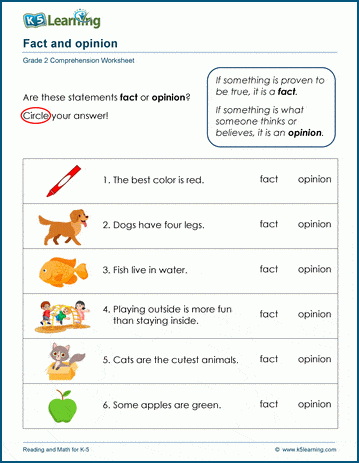
The easiest way to distinguish facts from opinions is to think of facts as statements that can be proven and of opinions as statements that cannot be proven and can be argued. Only factual statements are used.

Activity 1 The first activity is a simple worksheet.
Distinguishing fact from opinion exercises. The easiest way to distinguish facts from opinions is to think of facts as statements that can be proven and of opinions as statements that cannot be proven and can be argued. It may also be helpful to tell students that facts can be used to support opinions. Activity 1 The first activity is a simple worksheet.
Classify statements as a fact or an opinion. It is becoming increasing important and sometimes difficult for students to distinguish fact from opinion. In these reading worksheets students classify statements from a text as either fact or opinion.
Worksheet 1 Worksheet 2. Grade 3 - Fact vsOpinion Worksheets. Read short texts and determine if statements are facts or opinions.
Grade 4 - Distinguishing Facts from Opinion. Classify statements from longer texts as facts or opinions. Grade 5 - Fact or Opinion Worksheets.
Read Uncle Bens letters. Distinguishing Fact From Opinion Displaying top 8 worksheets found for - Distinguishing Fact From Opinion. Some of the worksheets for this concept are Passages with fact and opinion Passages with fact and opinion Distinguishing between facts and opinions in persuasive text Passages with fact and opinion Fact and opinion Identifying fact and opinion Fact or opinion Fact and.
Identifying fact and opinion Exercise in identifying fact and opinion from a personal account of the twenty-first century. Agony Aunt letter 1. Example An example of fact and opinion expressed in.
Fact or Opinion In order to read and understand the news to be able to make wise business decisions to participate effectively in committees or to succeed academically we need to be able to distinguish between fact and opinion. This package will focus on helping you to distinguish between fact and opinion and will present examples which demonstrate how both fact and opinion are blended in. Better understand the difference between fact and opinion.
A fact is considered something proven to be true. An opinion is a personal belief that is not founded on proof or certainty. Fact and Opinion Activities.
To become a skilled critical reader a student must develop the ability to quickly evaluate a text for fact and opinion. To achieve this they must practice distinguishing between fact and opinion to a point where it becomes a subconscious mechanism. The activities below will afford your students these necessary opportunities.
They can also easily be. Opinion A Multiple-Choice Fact Vs. Opinion B Multiple-Choice Fact Vs.
Opinion C Multiple-Choice Vocabulary Review Type in the Blanks Matching Matching Comprehension Open-Ended Questions Assessment Open-Ended Questions. Use this comprehension task when teaching students how to distinguish between fact and opinion when reading. A comprehension passage about zebras.
An answer sheet for teachers. Fact and Opinion. A statement that can be proven to be true.
It can be proven or disproven. Ones thoughts or feelings about something. It cannot be proven or disproven.
You must not include opinion statements in your reports. Only factual statements are used. A factual statement does not have to be true.
It only has to be proven or disproven. Look at the following example. Distinguishing Fact and Opinion.
Identify whether the statement is fact or opinion. Differentiating Fact from Opinion - YouTube. If playback doesnt begin shortly try restarting your device.
Distinguishing Between Fact and Opinion There are at least three reasons why it is frequently difficult to distinguish between a fact and an opinion. Use of similar linguistic structure and content. Because they tell something about the observable world facts are ex-pressed in terms of what philosophers call statement but most.
Distinguishing Fact Opinion Belief and Prejudice. When forming personal convictions we often interpret factual evidence through the filter of our values feelings tastes and past experiences. Hence most statements we make in speaking and writing are assertions of fact opinion belief or prejudice.
The usefulness and acceptability of an assertion can be improved or diminished by the nature of the.